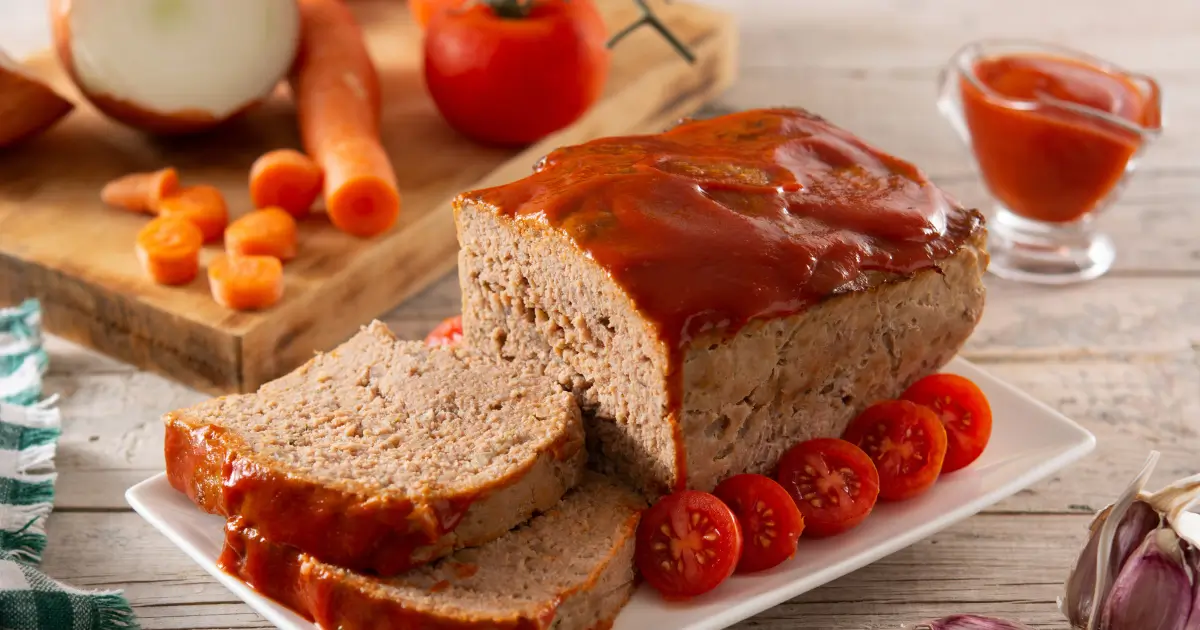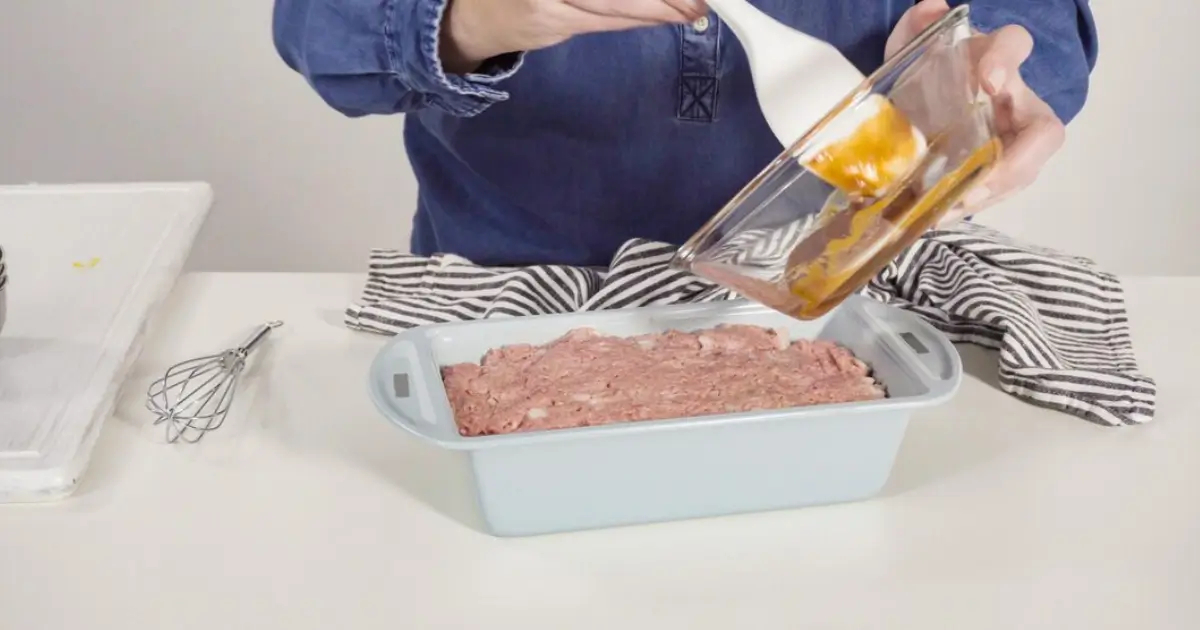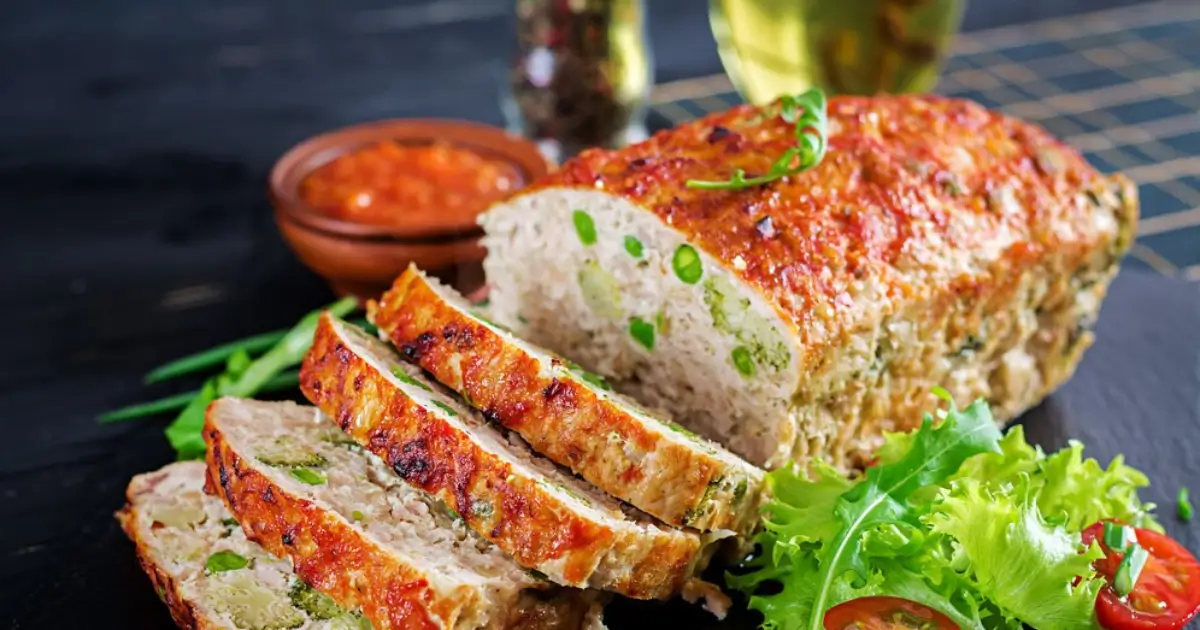Table of Contents
When making a delicious meatloaf, the glaze is key. It can make the flavor and texture better. You might wonder what to put on top of meatloaf for that extra kick. A good meatloaf glaze recipe can change everything, and we’re here to show you the best options.
A great meatloaf glaze recipe can turn an ordinary dish into something special. With the right mix of ingredients and techniques, you can make a glaze that’s both sweet and savory. Whether you want a classic recipe or something new, we’ve got you covered. Our aim is to help you find the perfect meatloaf glaze that fits your taste and dietary needs.
Key Takeaways
Here are the main points to consider when making the perfect meatloaf glaze recipe:
- Choose a meatloaf glaze recipe that balances sweet and savory flavors
- Consider the type of meatloaf you are making and the flavors you want to complement
- Experiment with different ingredients and techniques to find the best meatloaf glaze for your taste
- A good meatloaf glaze recipe can make or break the dish, so don’t be afraid to try new things
- Look for a meatloaf glaze recipe that is easy to make and requires minimal ingredients
- Don’t be afraid to get creative and add your own twist to a classic meatloaf glaze recipe
Understanding the Basics of Meatloaf Glaze
A great meatloaf glaze is sweet, savory, and a bit sticky. It should balance flavors that enhance the meatloaf. Try a simple recipe with ketchup, brown sugar, and spices.
Getting the flavor right is key. You don’t want it too sweet or too savory. Adjust the sugar and spices to find the perfect mix. More brown sugar makes it sweeter, while more spices make it savory.
What Makes a Great Glaze
A great glaze is easy to apply and has a rich flavor. Use ketchup, brown sugar, and spices for a tasty mix. Try different sugars like honey or maple syrup for a unique taste.
The Science Behind Glazing
Glazing involves the Maillard reaction. This chemical reaction creates new flavors and browns the meatloaf. Apply the glaze at the right time and temperature to enhance this reaction.
Timing Your Glaze Application
Timing is crucial for glazing. Apply it when the meatloaf is almost done. This allows the glaze to set and caramelize, making it sticky and flavorful. Try brushing it on in the last 10-15 minutes of cooking.
| Glaze Ingredient | Quantity | Purpose |
|---|---|---|
| Ketchup | 1/2 cup | Base flavor |
| Brown sugar | 2 tablespoons | Sweetness and caramelization |
| Spices | 1 teaspoon | Additional flavor |
Follow these tips and try different recipes to make a delicious glaze. It will impress everyone at your table.
Essential Ingredients for Classic Meatloaf Glaze Recipe
To make the best meatloaf glaze, you need a mix of sweet, sour, and savory flavors. A classic recipe includes ketchup, brown sugar, vinegar, and spices. These ingredients blend to give a rich, tangy taste that goes well with meatloaf.

Using top-quality ingredients is key for a great meatloaf glaze. Ketchup brings a deep, slightly sweet taste. Brown sugar adds a caramel-like flavor. Vinegar balances the sweetness, and spices add a warm, aromatic taste. Here are the essential ingredients:
- Ketchup: provides a rich, tangy flavor
- Brown sugar: adds a deep, caramel-like flavor
- Vinegar: balances the sweetness
- Spices: adds a warm, aromatic flavor
A great meatloaf glaze can elevate your dish’s flavor and texture. By mixing the right ingredients, you can make a sweet and tangy glaze that perfectly complements your meatloaf. Whether you’re after a classic or something new, finding the right flavor balance is crucial.
| Ingredient | Quantity | Flavor Profile |
|---|---|---|
| Ketchup | 1/2 cup | Rich, tangy |
| Brown sugar | 1/4 cup | Deep, caramel-like |
| Vinegar | 2 tablespoons | Sour, balancing |
| Spices | 1 teaspoon | Warm, aromatic |
The Perfect Balance of Sweet and Savory in Glazes
Creating a tasty glaze for meatloaf means finding the right mix of sweet and savory. A good glaze should be a bit sweet and tangy. Start with a ketchup glaze and tweak the sugar and acid levels to taste.
The sugar-to-acid ratio is key to a great glaze. It affects the flavor and texture. Use brown sugar, vinegar, and spices to adjust this ratio. For example, adding brown sugar can balance the ketchup’s acidity.
Sugar-to-Acid Ratio
To get the sugar-to-acid ratio just right, follow these tips:
- Begin with a basic glaze recipe and adjust the sugar and acid to your liking.
- Combine sweet and sour ingredients like ketchup, brown sugar, and vinegar.
- Try different spices and seasonings to boost the glaze’s flavor.
Seasoning Your Glaze
Adding spices and herbs can make your glaze taste amazing. Use smoked paprika, garlic powder, or dried oregano for extra flavor. Fresh herbs like parsley or thyme can add a fresh taste to your glaze.
| Ingredient | Quantity | Purpose |
|---|---|---|
| Ketchup | 1 cup | Base for glaze |
| Brown sugar | 2 tablespoons | Balances acidity |
| Vinegar | 1 tablespoon | Adds tanginess |
| Smoked paprika | 1 teaspoon | Enhances flavor |
By following these tips and experimenting, you can make a delicious glaze for meatloaf. Whether you’re using ketchup or trying something new, aim for a sweet and savory balance. This will make your dish unforgettable.
Traditional Ketchup-Based Glaze Techniques
Creating a tasty ketchup glaze for meatloaf is all about finding the right balance of flavors. A classic meatloaf glaze recipe mixes ketchup, brown sugar, vinegar, and spices. Ketchup brings a deep, sweet taste, while brown sugar adds a caramel flavor. Vinegar balances the sweetness, and spices add a warm, aromatic touch.
To make a traditional ketchup-based glaze, you’ll need:
- 1 cup of ketchup
- 1/2 cup of brown sugar
- 2 tablespoons of vinegar
- 1 teaspoon of spices (such as paprika, garlic powder, and onion powder)
Mix these ingredients in a saucepan and heat it over medium, stirring constantly. Once boiling, lower the heat and simmer for 5 minutes. This makes the glaze thicker. Brush the ketchup glaze for meatloaf over the meatloaf for the last 15-20 minutes of baking. It will add a rich, tangy flavor and a beautiful caramelized crust. This simple meatloaf glaze recipe will make your meatloaf delicious and traditional.
| Ingredient | Quantity |
|---|---|
| Ketchup | 1 cup |
| Brown sugar | 1/2 cup |
| Vinegar | 2 tablespoons |
| Spices | 1 teaspoon |
Alternative Meatloaf Toppings Beyond Ketchup
Looking for the best meatloaf glaze? You might want to try something other than ketchup. A great glaze can make your meatloaf stand out. Here are some tasty alternatives to ketchup.
Think about your favorite flavors when choosing a meatloaf topping. Want something spicy? Try a mustard-based glaze. Prefer sweet? A barbecue glaze could be perfect.
Mustard-Based Glazes
Mustard glazes add a tangy, spicy kick. Mix Dijon or whole-grain mustard with brown sugar or Worcestershire sauce. This creates a unique and tasty glaze.
Barbecue Style Options
Barbecue glazes bring a sweet, smoky flavor. They often include honey, molasses, or apple cider vinegar. These ingredients add depth and pair well with meatloaf.
Savory Mushroom Toppings
Savory mushroom toppings offer a rich, earthy taste. Mix sautéed mushrooms with herbs for a filling and flavorful option.
| Glaze Option | Ingredients | Flavor Profile |
|---|---|---|
| Mustard-Based | Mustard, brown sugar, Worcestershire sauce | Tangy, slightly spicy |
| Barbecue Style | Honey, molasses, apple cider vinegar | Sweet, smoky |
| Savory Mushroom | Mushrooms, herbs, garlic | Deep, earthy |
The best meatloaf glaze enhances the meatloaf’s flavors. Experiment with different toppings to find your favorite. This way, you can enjoy a delicious, elevated meatloaf meal.
Brown Sugar Substitutes for Your Glaze
When making a meatloaf glaze recipe, brown sugar adds a sweet, caramel-like taste. But, you can swap it out for other ingredients to make a unique glaze for meatloaf. Honey, maple syrup, and molasses are great options. They all have a similar sweetness but taste different.
You can use the following substitutes in your meatloaf glaze recipe:
- Honey: adds a lighter, more floral flavor
- Maple syrup: provides a richer, more complex flavor
- Molasses: offers a deeper, more robust flavor
Remember, these ingredients are sweeter and taste different from brown sugar. You might need to adjust how much you use in your glaze for meatloaf recipe. Trying out these substitutes can help you make a tasty meatloaf glaze recipe that you’ll love.
| Substitute | Flavor Profile | Sweetness Level |
|---|---|---|
| Honey | Lighter, floral | Milder |
| Maple syrup | Richer, complex | Sweeter |
| Molasses | Deeper, robust | Less sweet |
Using these substitutes in your meatloaf glaze recipe lets you try different flavors. Mix and match to find the perfect taste for your glaze for meatloaf.
Proper Baking Techniques for Glazed Meatloaf
To get the best meatloaf glaze, focus on the right baking techniques. You want the meatloaf’s internal temperature to hit 160°F. This is possible by baking at 350°F for 45-60 minutes. Apply the ketchup glaze in the last 15-20 minutes to avoid burning.
Some wonder if they should cover meatloaf while baking. The choice depends on the glaze’s texture and taste you prefer. Covered baking keeps the meatloaf moist and tender. Uncovered baking makes the glaze crispy and caramelized. Here are some tips:
- Bake covered for a tender, moist meatloaf with a sweet and tangy glaze.
- Bake uncovered for a crispy, caramelized glaze and a well-browned meatloaf.
- Use a combination of both covered and uncovered baking to achieve the perfect balance of texture and flavor.
By using these baking techniques and the best meatloaf glaze recipe, you’ll make a delicious glazed meatloaf. Always choose a high-quality ketchup glaze. Adjust the baking time and temperature to get the perfect result.
| Baking Method | Temperature | Time | Result |
|---|---|---|---|
| Covered | 350°F | 45-60 minutes | Tender, moist meatloaf with sweet and tangy glaze |
| Uncovered | 350°F | 45-60 minutes | Crispy, caramelized glaze and well-browned meatloaf |
| Combination | 350°F | 45-60 minutes | Perfect balance of texture and flavor |
Troubleshooting Common Glaze Problems
When you’re making a meatloaf glaze recipe, you might run into some common issues. One big problem is a glaze that’s too thin or too thick. To fix this, you can tweak the ingredients or cooking time. For example, if it’s too thin, add more brown sugar or ketchup. If it’s too thick, a bit of water or vinegar will help.
Another issue is a glaze that tastes too sweet or too sour. To fix this, adjust the sugar or acid in your glaze for meatloaf. If it’s too sweet, a splash of vinegar or lemon juice can help. If it’s too sour, a bit more sugar or honey will sweeten it up.
Here are some common glaze problems and their solutions:
- Too thin: add more brown sugar or ketchup
- Too thick: add a small amount of water or vinegar
- Too sweet: try balancing the flavor with a splash of vinegar or a squeeze of lemon juice.
- Too sour: add a little more sugar or honey
By tackling these common glaze problems, you can make a tasty meatloaf glaze recipe. Always taste and adjust your glaze as you go. Don’t be afraid to try different ingredients and flavors to find the perfect glaze for meatloaf for you.
| Problem | Solution |
|---|---|
| Too thin | Add more brown sugar or ketchup |
| Too thick | Add a small amount of water or vinegar |
| Too sweet | Add a splash of vinegar or lemon juice |
| Too sour | Add a little more sugar or honey |
Making Your Glaze Ahead of Time
Preparing the best meatloaf glaze ahead of time can save you a lot of time. A ketchup glaze for meatloaf, for example, can be made early and stored for later. This is especially helpful when you’re busy.
It’s important to know how to store and reheat your glaze. Storing it right keeps the flavor and texture good. You can keep it in the fridge for a week or freeze it for three months. To use it, just reheat it in the microwave or on the stovetop.
Storage Tips
- Refrigerate your glaze in an airtight container for up to a week.
- Freeze your glaze in an airtight container or freezer bag for up to three months.
Reheating Methods
To reheat your glaze, you can use the following methods:
- Microwave: Heat the glaze in short intervals, stirring between each interval, until it reaches the desired temperature.
- Stovetop: Simmer the glaze over low heat, stirring occasionally, until it reaches the desired temperature.
By making your glaze ahead of time and storing it right, your meatloaf will always have the best glaze. This can make your meatloaf a favorite in your home.
Specialty Glazes for Different Dietary Needs
Creating a meatloaf glaze recipe that meets everyone’s dietary needs is key. You can make a glaze for meatloaf that suits various restrictions. This way, everyone can enjoy this classic dish. Whether you’re looking for sugar-free or gluten-free options, there are many ways to make a delicious glaze.
For those with dietary restrictions, you can use sugar-free ingredients like honey or maple syrup. These alternatives offer a similar flavor to traditional glazes. For gluten-free options, try using gluten-free soy sauce or tamari. These ingredients add a rich, savory taste to your glaze.
Sugar-Free Options
- Opt for honey or maple syrup as natural sweeteners.
- Opt for sugar-free ketchup or tomato sauce
- Experiment with fruit-based ingredients, such as apricot jam or orange marmalade
Gluten-Free Variations
- Use gluten-free soy sauce or tamari to add depth and umami flavor
- Choose gluten-free Worcestershire sauce or make your own using gluten-free ingredients
- Select gluten-free spices and seasonings to add flavor to your glaze for meatloaf
By considering your guests’ dietary needs, you can make a meatloaf glaze that’s delicious for everyone. A little creativity and experimentation can help you create a glaze that’s both tasty and inclusive.
| Dietary Restriction | Ingredient Substitution |
|---|---|
| Sugar-Free | Honey, maple syrup, or fruit-based ingredients |
| Gluten-Free | Gluten-free soy sauce, tamari, or gluten-free spices and seasonings |
Expert Tips for Glaze Application
To get the best meatloaf glaze, applying it right is key. Apply the glaze in the last 10-15 minutes of baking. This prevents it from burning or getting too dark. It’s especially good for ketchup glaze, balancing sweet and savory flavors.

For even coverage, use a brush or spoon. This is crucial with ketchup glaze, which can be thick and sticky. Here are more tips for glaze application:
- Choose a high-quality ketchup glaze for meatloaf, made with fresh ingredients.
- Spread the glaze thinly and evenly to avoid overpowering the meatloaf.
- Try a best meatloaf glaze recipe that mixes sweet and savory, like brown sugar and Worcestershire sauce.
By following these tips and using top-notch ketchup glaze, you’ll make a delicious and attractive best meatloaf glaze. It will take your meatloaf to the next level.
| Glaze Type | Application Method | Result |
|---|---|---|
| Ketchup Glaze | Brush or Spoon | Even, Consistent Coating |
| Best Meatloaf Glaze | Thin, Even Layer | Balance of Sweet and Savory Flavors |
Conclusion: Mastering Your Meatloaf Glaze
Discovering the perfect meatloaf glaze recipe is key to making your homemade meatloaf stand out. It’s all about finding the right mix of sweet and savory. Plus, knowing the science behind glazing can make your dish a hit with everyone.
Choosing a classic glaze for meatloaf or trying something new, the tips here will help you. With practice and the right ingredients, your meatloaf will have a shiny, caramelized outside. And it will be juicy and full of flavor inside.
So, become a meatloaf master and try out these tips. You’ll get lots of praise for your perfectly glazed meatloaf. Your cooking journey is starting, and there’s so much you can do with this classic dish.
FAQ
What makes a great meatloaf glaze?
A great meatloaf glaze has sweet, savory, and tangy flavors. It’s all about finding the right mix of sugar, acid, and spices.
What are the essential ingredients for a classic meatloaf glaze recipe?
The key ingredients for a classic glaze are ketchup, brown sugar, vinegar, and spices. These give a sweet, sour, and savory taste that goes well with meatloaf.
Can I substitute brown sugar in a meatloaf glaze recipe?
Yes, you can swap brown sugar for other sweeteners like honey, maple syrup, or molasses. They offer a similar taste but with a unique twist.
Is it best to cover meatloaf when baking?
Whether to cover or not cover the meatloaf affects the glaze. Covering keeps the glaze moist, while leaving it uncovered creates a caramelized crust.
Can I make the meatloaf glaze ahead of time?
Yes, you can prepare the glaze before baking. Just refrigerate or freeze it, then warm it up before brushing it on the meatloaf.

